September 11, 2020, by Kathryn Steenson
Microscopy
Post by Ursula Ackrill, Special Collections Librarian.
“It seemed to me,” said Swammer, coming close to Peregrine, “it seemed to me, my dear Mr. Tyss, as if a flea were on your collar.”
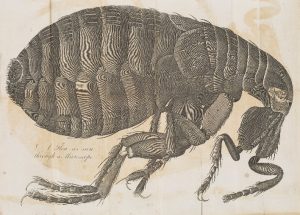
A flea as seen through a microscope from ‘The wonders of the microscope, or, An explanation of the wisdom of the Creator, in objects comparatively minute…’ (1811). Briggs Collection of Educational Literature LT109.QH/W6
This image is a pirated reproduction of Robert Hooke’s drawing of a flea in ‘Micrographia: Some physiological descriptions of minute bodies made by magnifying glasses with observations and inquiries thereupon’ (1665). Available online
Peregrine Tyss, the protagonist of E. T. A. Hoffmann’s humorous fantasy novel ‘Master Flea’ (1822), does keep the company of a friendly flea. Not a simple flea as we are told but a graduate and, as he clearly shows over the course of the novel, a superior scientist of microscopy too. In a fantastic twist on the 17th century lens technology which magnified the flea’s body up to 275 times, Master Flea develops a microscope so small and subtle – flea-sized – that it can be inserted into the pupil of the viewer’s eye to make the eye microscopic, affording it magnification powers, and more than that:
“Now is the time!” whispered Master Flea, and in the same moment Peregrine felt a slight passing pain in the pupil of his left eye. He knew that Master Flea had placed the microscopic glass in his eye, but he had not before had the slightest idea of its effects. Behind the tunicle of Swammer’s eyes he perceived strange nerves and branches, the perplexed course of which he traced deep into the forehead, and could perceive that they were Swammer’s thoughts.
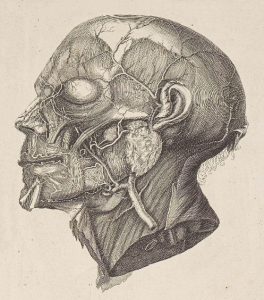
Anatomical diagram from Tables of the skeleton and muscles of the human body by Bernhard Siegfried Albinus (1749)
Nottingham Medico-Chirurgical Society Library Oversize XX WE17ALB
Whenever the microscope enters Peregrine’s eye, he sees not only his interlocutors’ nerves and veins working on the brain but overhears their resulting thoughts and yearnings too. The microscope is a mind reader. Initially Peregrine enjoys this power, sidestepping deceptions by which people try to get the better of him. However, on balance he prefers to give people the benefit of the doubt and retain his guilelessness. Master Flea concedes that a perpetual knowledge of people’s real sentiments would overwhelm a person, though fleas are alright; a prescient risk-assessment of our current sharing in public spaces through mass and social media. At the very least, whilst empowered by Master Flea’s microscope, Peregrine manages to cast off his fear of talking to girls. Conveniently they prove to be dummies. “The prettiest girl in all Frankfort” reckons such: “I will have him, because I want a rich man, that I may sleep till twelve o’clock in the day, and wear dearer shawls than my sister.” Eventually, when his heart is at stake, Peregrine has the sense to refrain from using the microscope altogether, as he befriends the gentle daughter of a bookbinder – a nice save.
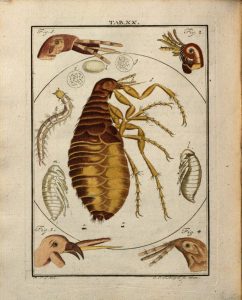
Der Floh. Coloured copperplate engraving from ‘Mikroskopische Gemüths- und Augen-Ergötzung: bestehend, in Ein Hundert nach der Natur gezeichneten und mit Farben erleuchteten Kupfertafeln, Sammt deren Erklärung by Martin Frobenius Ledermüller’ (1761). Available online
Image courtesy of Münchener DigitalisierungsZentrum Digitale Bibliothek
E. T. A. Hoffmann was decidedly interested in microscopy. Swammer and Leuwenhock, the two microscopists featured – and mercilessly derided – in the novel are fictional avatars of two Dutch scientists who founded the discipline. Swammer is none other than the pioneering microscopist Jan Swammerdam (1637-1680) whose magnum opus ‘Bybel der natuure, The book of nature, or, The history of insects’, published posthumously in 1737, was known to E.T.A. Hoffmann. The title is represented in our Special Collection with a copy of its 1758 English translation. It is a compendium of Swammerdam’s work, revealing intricate insect anatomies and other natural wonders invisible to the naked eye. Swammerdam lived on the brink of the Age of Enlightenment and ushered it in with his works. However, he believed in divine design and was at pains to credit the revelations of the lens to God the Creator. An even more important scientist was Antonie van Leeuwenhoek (1632-1723). Originally a draper, he took up lensmaking as he needed better lenses to see the fine threads in the weaves he was selling. His science advanced by experiment over a long career, during which he applied lens technology to his other passion: exploring microorganisms. He documented his discoveries in 190 letters sent to the Royal Society (founded 1660 in London) and was elected to the Society in 1680.
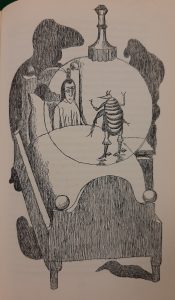
Illustration by Ruth Knorr from Meister Floh: ein Märchen in sieben Abenteuern zweier Freunde by E. T. A. Hoffmann (1972, © 1822) Magdeburg Public Library Collection PT2360.M5
Leeuwenhoek delighted in the study of microbes, which he originally referred to as dierkens, diertgens or diertjes (Dutch for “small animals”, translated into English as animalcules). This is significant because the female protagonist in ‘Master Flea’ whose otherworldly beauty ensnares all leading men – except the flea – is called Dörtje Elverdink. “Dörtje” is likely to be an homage to the scientist Leeuwenhoek, who in the tale acts as the beauty’s immortal creator and jailor. The novel is a romantic reversal of fates, which begins with Master Flea captive in Leuwenhock’s flea circus, from where he escapes knowing more about magnifying glasses than Leuwenhock and his close competitor Swammer together ever did. The two monomaniacal scientists, whose genius enables them to traverse history and swap reality for worlds of pure myth, are on a mission to recapture Master Flea and take away his microscope, which surpasses their inventions. Dörtje acts as their lure, inducing men to capture and return the flea to “science”. She is both fairy princess and silvery animalcule underneath the appearance of a girl. Peregrine is practically proposing marriage to her when she asks, Salome-like, for the handover of Master Flea, who just then hides in Peregrine’s necktie. Peregrine leaves her in suspense; suffice it to say that he then strolls over to the bookbinder’s to check out his volumes.
But how did the idea of the flea character, “extremely graceful and handsome, in a glittering scale-breastplate, and highly-polished golden boots”, occur to E.T.A. Hoffmann? If Swammerdamm’s book is abundantly illustrated for its time, it does lack an image of a flea. However, nearly a decade before Leeuwenhoek’s correspondence with the Royal Society an English scientist created an image of a flea which caused a ripple effect beyond his time. Robert Hooke (1635-1703) was appointed as curator of experiments to the then newly founded Royal Society, and in 1663 and 1664 he produced microscopy observations and artwork that he subsequently published as ‘Micrographia’ (1665). His book has 38 pictorial works of great artistry. A digital copy can be downloaded through our catalogue NUsearch and is openly accessible online.
At the height of the English Romantic Movement in 1811, Hooke’s images of a flea and a louse were even reprinted in a book for children, ‘The wonders of the microscope, or, An explanation of the wisdom of the Creator, in objects comparatively minute’, a copy of which is held in our Briggs Collection of Educational Literature. Though pirated from ‘Micrographia’ and shown unattributed, they are printed in high definition and on large fold-out papers. The proliferation of Hooke’s images at this time is likely to have brought them to the attention of William Blake (1757-1857) who printed his ‘Ghost of a Flea’ in c. 1819-20, although Blake would have grown up knowing Hooke’s work in the crucible of London’s printmaking trade. Manuscripts and Special Collections showed Robert Hooke’s image of a flea in the natural sciences chapter of our exhibition Romantic Facts and Fantasies (2019) alongside a microscope and early 19th century specimen slides.
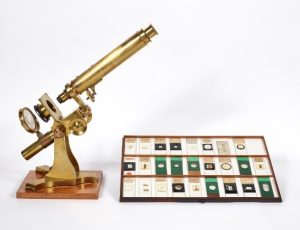
Compound microscope (1850-55) and slides (19th century)
School of Life Sciences, University of Nottingham
It is not known whether Hoffmann knew Hooke’s image of a flea. Hoffmann is more likely to have seen Martin Ledermüller’s (1719-1769) plate of ‘Der Floh’, given that Hoffmann likens Master Flea to a bird, which Ledermüller’s drawings seem to suggest. Ledermüller published it in his collected edition of drawings and accompanying scientific writings in Nuremberg in 1763. The compendium has one hundred and fifty coloured copperplates drawn by the author from specimens he studied under the microscope. His book was translated into French and Dutch and his correspondence with the philosopher J.C. Gottsched and several natural scientists helped keep his name current. Only three libraries in the UK have collected Ledermüller’s book. We are fortunate to access it in digital format through NUsearch and view it online, courtesy of Bavaria State Library. It is titled: ‘Microscopic delectation for the mind and the eye’, and we recommend browsing its beautiful images.
E.T.A. Hoffmann’s introduction to Master Flea, shown below alongside a sample of popular scientific writing on the topic “Of the Flea”, have unexpected commonalities, particularly the tone of sharing something never before seen.
By the light of the lamp he perceived a little monster, scarce a span long, that sate upon the white counterpane, and which at first terrified him, but in the next moment he grasped boldly at it with his hand, to convince himself whether he was or was not deceived by his fancy; but the little monster had immediately disappeared without leaving a trace behind.
[…]
As already mentioned, the creature was scarcely a span long. In his bird-shaped head gleamed a pair of round sparkling eyes, and from his sparrow-beak protruded a long sharp thing like a rapier, while two horns came out from the forehead close below the beak. The neck began close under the head also, in the manner of a bird, but grew thicker and thicker, so that without any interruption the former grew to a shapeless body, almost like a hazelnut, and seemed covered with dark-brown scales like the armadillo. But the strangest part was the formation of the arms and legs; the two former had joints, and were rooted in the creature’s cheeks, close by the beak; immediately under these arms was a pair of legs, and still farther on another pair, both double-jointed like the arms. These last feet appeared to be those on which the creature really relied; for besides that they were longer and stronger than the others, he wore upon them very handsome golden boots with diamond spurs.
Master Flea by E. T. A. Hoffmann. Originally published in 1822. The Project Gutenberg EBook of Specimens of German Romance; Vol. II. Available online
This well-known little Creature is covered all over in black hard shelly scales, plates and divisions, curiously jointed, and folded over one another, in such a manner, as to comply with all the nimble motions and activity of the animal. The scales are curiously polished, and beset about the edges with long spikes, in the most beautiful and regular order possible. Its neck is finely arch’d and much resembles the form of a lobster’s tail. The head is very extraordinary; for from the snout-part thereof proceed its two fore-legs, and between them lies the piercer or sucker wherewith it penetrates the skin of other living creatures, and draws out its food. It has two large beautiful black eyes, and a pair of little horns or feelers. Four other legs are join’d on at the breast, so that it has fix in all; which, when it leaps, fold short one within another, and exerting their spring all at the same instant, carry the creature to a surprising distance. The legs have many joints, are very hairy, and terminate in two long sharp hooked claws, as may be seen. The Flea’s piercer or sucker is lodged between its fore-legs, and includes a couple of darts or lancets, which, after the piercer has made an entrance, are probably thrust farther into the flesh, to make the blood flow from the adjacent parts, that it may be sucked up; and seems to occasion that round red spot, with a hole at the centre of it, which we commonly call a flea-bite.
The microscope made easy: or, I. The nature, uses, and magnifying powers of the best kinds of microscopes described, calculated, and explained: … II. An account of what surprizing discoveries have been already made by the microscope: … And also a great variety of new experiments and observations, … by Henry Baker. Originally published in 1769. Electronic resource available on NUsearch.
The works presented here are held at Manuscripts and Special Collections and can be accessed online where indicated. We are currently closed because of Coronavirus, but once we reopen, they will be available to view upon request in our Reading Room at King’s Meadow Campus.

Great post with excellent materials. I will refer to it in my MLA talk in January 2022 entitled:
Fantasies of Mechanical Non-Conforming Bodies. Hybrid Imagery in Action